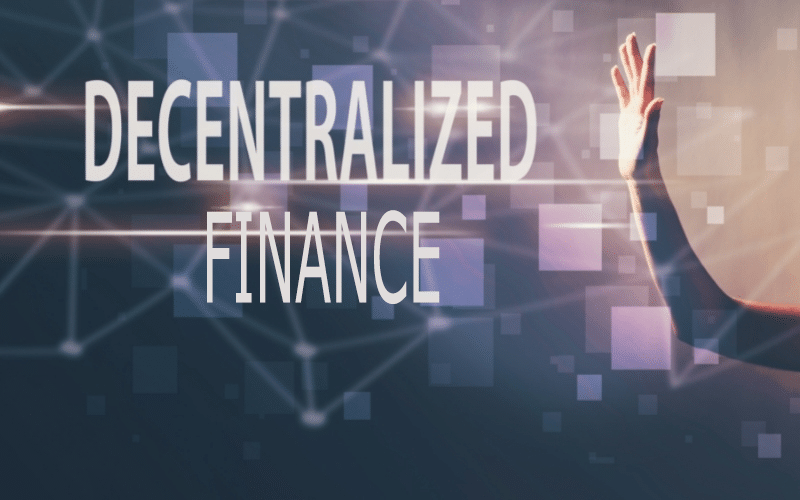In the crypto space, DeFi or decentralized finance seems to be one of the buzzwords. According to CryptoSlate, the DeFi sector dominates about 5% of the entire market capitalization, which is worth roughly $87 billion.
Analysts are confident this figure will continue to increase and that DeFi will play a critical role in integrating cryptocurrencies into the mainstream. However, the concept may seem like a mystery to the layman.
Fortunately, once we understand some fundamentals, we’ll soon realize the idea is relatively simple; making finance systems better overall. This article will define DeFi broadly, how it works, examples of applications using it, and the pros and cons.
So, what is DeFi?
Decentralized finance is an innovative, blockchain-based form of finance essentially cutting out the middleman. By middleman, we refer to any intermediary such as a bank, broker, exchange, or other agents.
This mechanism is all possible thanks to peer-to-peer blockchain applications using smart contracts to create a trustless, permissionless environment while still carrying out transactions efficiently, quickly, and inexpensively.
In essence, DeFi is aiming to replace traditional finance. Doing away with the need for a third party makes the whole process a lot faster, cheaper, more secure, and transparent. For instance, if someone needed a secured loan with a typical financial institution, they would need to go through lengthy verification checks and other time-consuming processes.
Moreover, the user will probably have to pay high administration fees to the organization facilitating the deal. However, on a DeFi platform, this system would be much quicker where the blockchain will have all the required user information.
It can also automatically determine the value of the security or collateral and other crucial Ts and Cs to the transaction, all for a reasonable fee. Popular examples of DeFi in action include crypto lending, yield farming, decentralized exchanges, saving accounts, wallet services, and more.
What are smart contracts?
One of the key elements of gluing DeFi is smart contracts since this is the mechanism for ensuring conditions are fulfilled without a central establishment or legal system to enforce trust and permission.
A smart contract is an autonomously executing contract application or program existing on a blockchain written using lines of code. In simpler terms, it is a digital version of a physical or paper contract.
Two parties get together and define a set of terms and conditions to create the contract. Once the agreement is in place, the code ensures the deal is verifiable and irrevocable on the blockchain. More significantly, the contract would self-fulfill when certain conditions are met.
In DeFi, smart contracts are the perfect solution since they are swift, efficient, trustless, and immutable, reducing operational costs tremendously. The genius of this mechanism is its utility in virtually any scenario where two independent parties like buyers and sellers need a contractual system without requiring an intermediary.
Examples of DeFi applications
Let’s look at a few popular DeFi applications in the market.
Uniswap
Uniswap is the largest decentralized exchange presently, with a market cap of about $15.76 billion. The exchange exists on the Ethereum blockchain, where users swap ERC20 or Ethereum-based tokens.

Uniswap itself has its own utility coin, UNI, which traders transact with on the platform. So, what are some of the key distinctions between Uniswap and a centralized exchange like Coinbase?
It boils down to how the former creates liquidity or markets for the tokens on offer. With a brand like Coinbase, they rely on an order book created by their designated market makers. An order book is merely an electronic list of buy and sell orders with prices matched continuously depending on supply and demand.
In the case of Uniswap, this model doesn’t exist. Instead, its users are chiefly the liquidity or market providers, getting rid of the need for an order book and instead of using an automated, formulaic model.
Traders can join a liquidity pool by depositing two tokens in a pair, e.g., ETH/USDT. So, when others on the platform need to buy ETH or USD, they pay a small fee to the pool that contributors can redeem via a specific token like UNI.
Therefore, Uniswap incentivizes users to provide liquidity to grow their cryptocurrency holdings.
Aave
Aave (pronounced ‘ah-veh’) is another Ethereum-based DeFi application sharing some commonalities with Uniswap. At its core, Aave is a place for users to borrow and lend cryptocurrencies and earn interest from their holdings through lending and staking.

Traders can trade various coins like Chainlink, Binance Coin, Maker, Basic Attention, Synthetix, Tether, etc. As a borrower, one needs to put up collateral in the form of a digital currency, which is essentially a secured loan but with more reasonable interest and fees.
Smart contracts take custody of the deposited funds and also lend out the required crypto to the loanee. Furthermore, since Aave has its own utility token, AAVE, users can also earn rewards through the coin.
Pros and cons of DeFi
Despite all the marvels of DeFi, it is still effectively a developing technology with some flaws. Let’s have a brief look at the pros and cons.
Pros
All the problems centralized finance has faced for decades like high fees, go-betweens, lack of transparency, and slowness are practically absent with DeFi. Another crucial factor pointed by analysts is the roughly 1.7 billion unbanked people on the planet.
Experts believe DeFi is more accessible than traditional banks since less documentation is required. DeFi apps are also autonomous, where users control their funds, drastically decreasing the likelihood of assets or money being frozen or blocking of transactions.
Cons
Unfortunately, DeFi is a complex concept for many people to grasp currently. It will take perhaps a few years of adoption before more begin to understand it fully. Secondly, although traders have custody of their holdings in many cases, this can cause issues such as lost private keys, forgotten passwords, and mistyped addresses.
Smart contracts themselves are at risk of attacks through coding bugs and other imperfections – an absent trait in traditional finance. Lastly, the regulatory landscape presently for the vast majority of DeFi applications is murky.
Final word
While DeFi is not yet perfect and rough around the edges, it has, for the most part, flipped traditional finance on its head. Many believe one of the best usages for cryptocurrencies isn’t acting as a medium of exchange but rather facilitating such applications.
In the near future, DeFi should introduce previously unheard-of services and products because of its autonomous nature to further revolutionize the financial industry.




